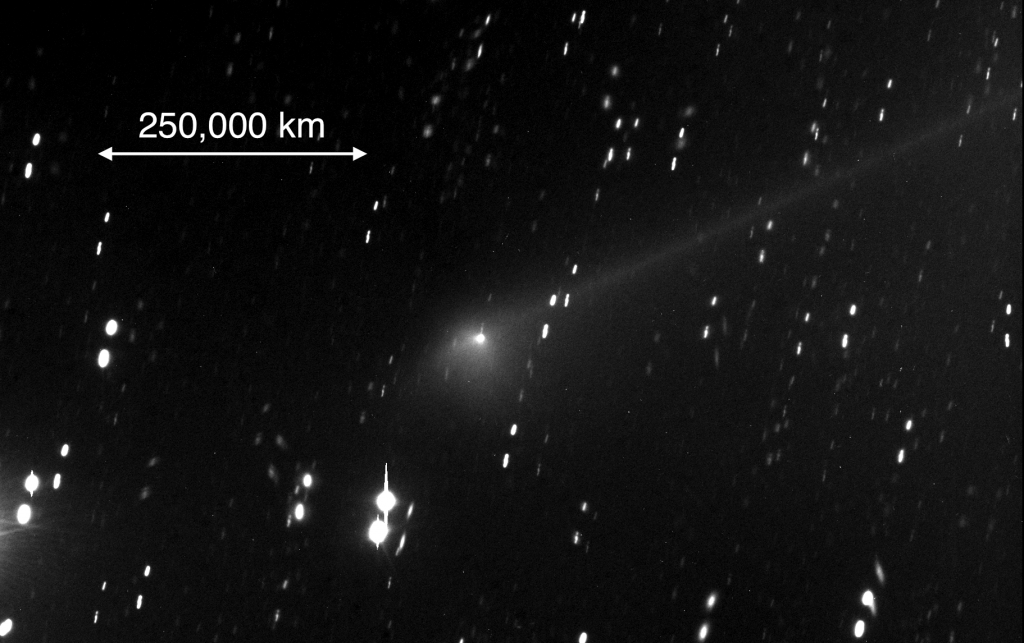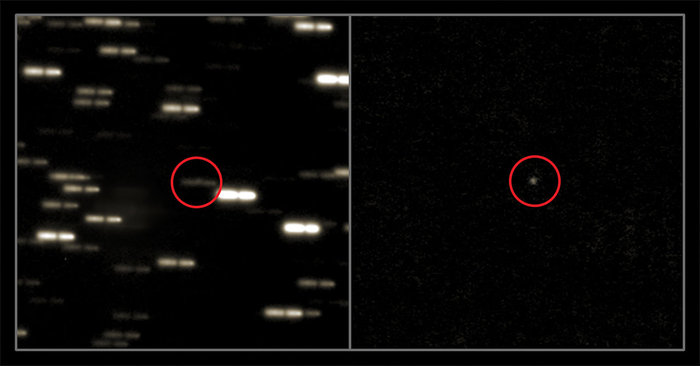Today’s guest post is by Colin Snodgrass from the Max Planck Institute for Solar System Research, Germany. Colin coordinates a consortium of professional astronomers observing comet 67P/Churyumov-Gerasimenko from Earth, and explains just how important it is to study this enigmatic object from afar, as well as up close.
Rosetta is on its way to the very heart of comet 67P/C-G, and will have a unique view of the small nucleus of ice and rock that forms the solid part of the comet. The probe will get closer to the nucleus – including landing Philae on it – than any other mission, and will return the most detailed images and other data ever taken of one of these icy bodies. Rosetta will completely change our understanding of comets, and it is easy to think that it will answer all the questions. But there are two important points to remember. Firstly, comets are huge, with a tenuous atmosphere (the coma) extending far into space; and secondly, 67P/C-G is only one comet, which may be different from its siblings.

Image of 67P/C-G taken with the ESO VLT in April 2003, shortly after it was selected as the Rosetta target, when the comet was relatively close to the Sun. The coma stretches over hundreds of thousands of km, and a trail of larger dust particles is left behind in the orbit of the comet, millions of km long. Rosetta will orbit inside the coma, entirely within a single pixel on the scale of this image! Image courtesy C. Snodgrass/ESO
Both amateur and professional astronomers are conducting a campaign of observations of 67P/C-G in support of Rosetta. Their findings will help to address these points. While Rosetta investigates the nucleus and inner core of the coma, observations from Earth get a wider view, taking in the entire coma and tails of the comet. In a sense, Rosetta cannot see the wood for the trees. Because it is designed to look in detail at the inner workings of the comet, it stays deep within the coma throughout its mission, orbiting between roughly 10 and 100 km from the nucleus, while the coma stretches over a thousand times further into space. Since the dust and gas in the coma all comes from the nucleus to start with, this is a sensible approach. Only an ambitious space mission like Rosetta can get at the comet’s heart, while astronomers on Earth can study the coma on larger scales.
Working together with ESA and the Rosetta science team, an international team of professional astronomers is using the world’s best telescopes to provide this crucial context information for the mission, observing 67P/C-G from Earth in parallel with Rosetta’s measurements.
Earth-based observations also provide a second important piece of the puzzle – they provide context not only in terms of the larger scale coma around the comet, but also in comparing 67P/C-G with other comets. As most comets will only ever be observed by astronomers rather than visited by spacecraft, the observing campaign gives us a frame of reference for interpreting other comets: when another comet appears similar to 67P/C-G through a telescope, we can confidently make deductions about its nucleus using results from Rosetta. In this way, we can keep learning more about comets using Rosetta data long after the mission itself ends. As the original Rosetta stone provided the key to reading hieroglyphics, so the Rosetta mission will provide the key to understanding comets: telescopic observations of comets generate a vast library of further stories to read with this key.

Comet 67P/C-G on 28 February 2014, seen with ESO’s VLT. Click image for full caption. Credit: ESO/C. Snodgrass (Max Planck Institute for Solar System Research, Germany) & O. Hainaut (ESO).
Our international campaign is made up of over 70 professional astronomers, and uses telescopes at major observatories all over the world. Some of these astronomers have been observing 67P/C-G for many years, keeping our sights on it while Rosetta has been making its long trek through the Solar System to catch up with the comet, and providing all of our current knowledge of the comet (such as its nucleus size and shape, and the pattern of its activity), to allow the Rosetta scientists to plan the mission. At the moment the comet is still relatively faint, and appears as a single star-like dot when viewed from Earth, so one of the world’s biggest telescopes – the European Southern Observatory’s ‘Very Large Telescope’, in Chile –is leading the efforts. Other telescopes involved at this stage are the TRAPPIST comet-chasing telescope, also in Chile, and the Nordic Optical Telescope, on La Palma in the Canary Islands.
As the comet approaches the Sun and gets brighter, many more telescopes will join in. Although the comet will not get bright enough to be seen with the naked eye, small telescopes will be able to detect it in 2015, and there are opportunities for amateur astronomers to join the campaign too.
Later this week we’ll have a guest blog post highlighting the 67P/C-G amateur astronomer observing campaign.









Discussion: one comment
When will be be able to look for the comet 67P.
We live in the south pacific and would love to try and see it.
What date will;l be the best viewing time.